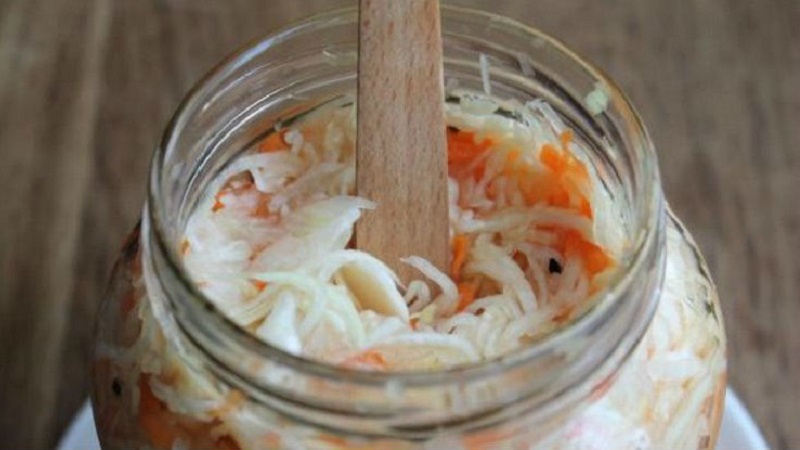When to pierce sauerkraut and why
Sauerkraut is considered even healthier than fresh cabbage. It is rich in compounds valuable for health and serves as a source of vitamins in winter. To properly salt cabbage, a number of rules are followed. In the article we will tell you whether you need to pierce the cabbage when pickling, and explain how to do it.
The content of the article
Why pierce sauerkraut
During fermentation, gas is formed, which must be released from the can... If this is not done, the taste may change for the worse. If you do not pierce the cabbage during the entire fermentation period, it will sour, and you will have to throw out the entire can.
The more gas accumulates in the product, the more liquid flows out of the can.... If the brine ceases to completely cover the cabbage mass, it will dry out from above, and this layer will have to be removed.

Do I have to do it
It is believed that if you cover the jar with a lid and make holes in it for gas to escape, it is not necessary to pierce the cabbage. But actually it is not. Gas can remain in depth, causing the entire contents of the can to sour and emit an unpleasant odor... A vegetable is fermented in a warm place, so the process of gas formation is inevitable there.
Important! If you have covered the workpieces with lids with holes, do not forget to exchange them for whole ones when sauerkraut will be ready. You don’t have to throw away the removed lids — rinse them out and use them for pickling next year.
When is it time to pierce the sauerkraut
On what day of fermentation to do it? Most often, cabbage is pierced already on the second day after cooking... A sure sign that the time has come is the formation of bubbles and foam on the brine surface. This means that the mustard gas has accumulated and it is time to release it.
Sometimes they start to pierce sauerkraut later. The term largely depends on the room temperature... The optimum temperature for the fermentation process is + 15 ... + 22 ° С. If you ferment a workpiece at home at a higher room temperature, it is important not to miss the moment of readiness and not to let the workpiece sour. You can put it in the refrigerator after three days and leave it there until tender.
How often to pierce
It is recommended to check the condition of the cabbage in the jar and release the air 2 times a day - in the morning and late in the evening. Do this every day until the completion of the fermentation process. On average, the whole procedure takes about a week - during this time the mass reaches full readiness and acquires a characteristic sweet and sour taste.
What can be pierced and what can not
It is recommended to use a long thin piece of woodsuch as a knitting needle or sushi stick. Housewives also use ceramic knives, as they are guaranteed to leave no smell. But in this case, they act with caution, since ceramics are fragile: if the tip of the knife breaks off, it will remain in the jar.
Do not puncture with a metal object... Housewives traditionally pierce the workpiece with an ordinary knife and make a big mistake. When interacting with metal, cabbage loses useful substances, although the taste may remain the same. In addition to metal, it is not recommended to use plastic, since in the case of poor quality, it can leave a foreign smell or color the vegetable.

How to do it right
To properly release air from the can, special knowledge and skills are not required:
- Select an item from the correct material (wood is preferred).
- Pierce to the bottom several times with a sharp object.
Attention! The blunt tip can compress the cabbage in the lower layers along with the gas.
When the brine in the jar is completely transparent, the cabbage is ready to eat. - it can be placed for long-term storage.
Take a note:
Advantages and disadvantages of the procedure
If you regularly release accumulated gases from the can, easy to achieve perfect taste sauerkraut... This does not require special devices and time consuming.
The only disadvantage of the procedure - you need to spend it on time. When starting to pickle, you must be sure that you do not need to go anywhere for at least a week.
Attention! A gas release is necessary if you want to get a high-quality and tasty product, so you should not even start making blanks if it is not possible to check cans and pierce cabbage daily.
Tips on the topic
Experienced housewives have a whole arsenal of secrets for salting cabbage:
- Sterilize the jars well before adding the vegetable mass.
- For blanks, do not take plastic or metal containers - only glass is suitable.
- Stack the shredded vegetable tightly to keep as little air as possible in the jar.
- The brine should completely cover the entire mass.
- During the fermentation process, the juice can overflow, so place each jar in a tray or other container.
- When piercing the cabbage, taste it. If it starts to taste bitter, pierce it more often.
- Do not be afraid to add spices: some bay leaves, allspice, caraway seeds, cloves. They go well with each other and make the taste more original. You can also add cranberries.
- Do not salt the cabbage with iodized salt. It is not suitable for any workpiece.
Conclusion
The correct fermentation process makes cabbage not only tasty, but also healthy. She herself is a natural source of vitamins. Sauerkraut brine is especially rich in vitamin C.
If you follow the recipes exactly and do not forget to pierce the cabbage in the jar, you will get a homemade preparation that will be stored for a long time in the cellar or refrigerator, preserving the original taste.